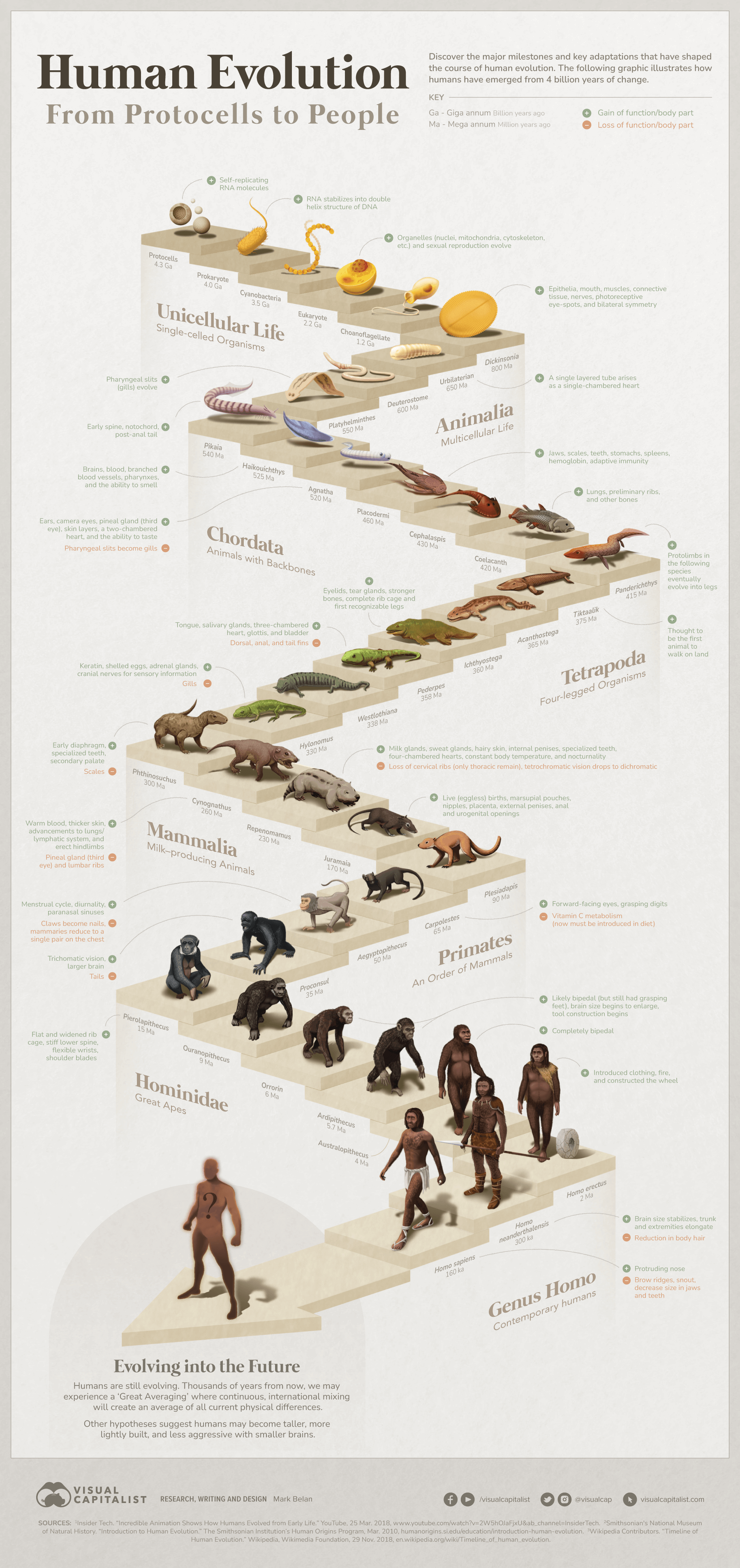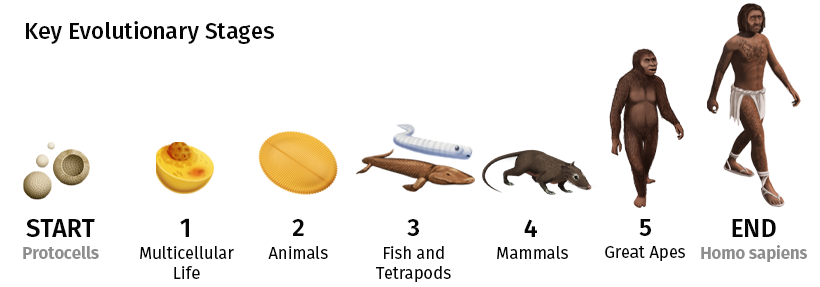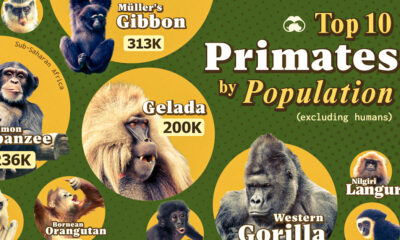Misc
Visualized: The 4 Billion Year Path of Human Evolution

The 4 Billion Year Path of Human Evolution
The story of human evolution is a fascinating one, stretching back in an unbroken chain over millions of years.
From the tiniest protocells to modern humans, our species has undergone a remarkable journey of adaptation, innovation, and survival.
In this article, we take a look at the key developmental stages in the evolution of life on Earth that led to the emergence of Homo sapiens—us!
From Protocells to People
Evolution is the result of millions of minute mutations over millions of years, but the evolutionary process that created us can bucketed into a few key categories.

1. Protocells and Early Microorganisms
The first life forms on Earth were simple, single-celled microorganisms known as protocells. These precursor cells lacked a nucleus or other membrane-bound organelles, and they had simple genetic proteins called RNA.
Over time, RNA complexified into the more stable DNA. Protocells slowly developed specialized organelles, becoming more complex microbes that would eventually form eukaryotes – the complex, unicellular organisms that would birth a diverse array of life forms, from simple sponges to complex animals.
2. The First Animals
Dickinsonia is the earliest example of an animal we know of. Though it was a simple, flat creature that lacked a mouth or digestive system, it symbolizes the first multicellular organism of substantial complexity.
Over time, the first sophisticated organ systems began to arise. Bilateral symmetry emerged, as well as early versions of the nervous and circulatory systems. Simple eyes, called eyespots, also appeared around the time that spinal cords and vertebrate creatures began to emerge.
3. Fish and Tetrapods
One of the most significant developments in the evolution of life was the transition from marine to terrestrial environments.
Up until 500 million years ago, all life was sequestered in the sea. Fish were the first vertebrates and introduced additional organs like stomachs, spleens, and body components like scales, teeth, blood, and more. Bony fish arose, and over time their development brought about sophisticated changes to the skeletal system, eventually producing “proto-limbs” that would enable organisms to walk on land.
Researchers are still unsure which specific organism might have first crawled on land, but candidates share these pre-limb characteristics. Tiktaalik is one popular candidate because it had specialized bones that suggest it could support its own weight while moving out of shallow waters.
These creatures eventually became the tetrapods (“four-footed”), and they had features like four-legs, a backbone, and lungs which could absorb oxygen from air. All the amphibians, reptiles, birds, and mammals that followed are descendants of the original tetrapods.
4. The First Mammals
Around 200 million years ago, the first mammals emerged. These early mammals were small, shrew-like creatures that lived alongside the dinosaurs. Over time, however, mammals evolved hair, specialized teeth, sweat glands to regulate body temperature, and a more efficient circulatory system.
Mammals also brought about features like nocturnality, mammary glands, external genitalia, and a variety of other features that distinguished them from other living species at the time, like birds or reptiles.
5. The Great Apes and First Homo Species
Around 7 million years ago, the first great apes emerged in Africa. These apes, such as orangutans, gorillas, and chimpanzees, were highly intelligent and social creatures that lived in complex communities. Over time, one lineage of apes would give rise to the first members of the genus Homo, which includes our own species.
The main developmental changes during this time were the full-time bipedalism of apes, increasing brain size, and advanced bone development that enabled dexterity for tool construction and hunting. Inventions like fire and clothing arose early in the Homo genus, and eventually complex language, hair loss, and dramatic facial changes would evolve.
Researchers struggle with resolving the exact progression of the Homo species. Many Homo species existed at the same time, and since many fossil records overlap, resolving which ones came first is an area of intense focus.
The Future of Human Evolution
As humans continue to evolve, we can expect to see significant changes in our physical and cognitive abilities over the next 10,000 years.
With the rise of technology and the increasing interconnectedness of the world, we may see a shift towards a more globalized and homogeneous human population, with less genetic diversity.
This has been described as “The Great Averaging”, where genetic diversity minimizes and we start to become more alike.
Other theories suggest that we might develop features like a taller, lighter build, with smaller brains and a less aggressive personality.
However, as with all evolution, these changes will be shaped by a complex interplay of genetic, environmental, and cultural factors. It is impossible to predict exactly how humans will evolve over the next 10,000 years, but one thing is certain: the future of human evolution will be shaped by the choices we make today.
Note: This is a complex topic with new research being published all the time. We’ll continue to dynamically update this graphic to reflect the most recent understanding of evolution.
United States
Charted: What Southeast Asia Thinks About China & the U.S.
A significant share of respondents from an ASEAN-focused survey are not happy about rising American and Chinese influence in the region.

What Southeast Asia Thinks About China & the U.S.
This was originally posted on our Voronoi app. Download the app for free on iOS or Android and discover incredible data-driven charts from a variety of trusted sources.
This chart visualizes the results of a 2024 survey conducted by the ASEAN Studies Centre at the ISEAS-Yusof Ishak Institute. Nearly 2,000 respondents were asked if they were worried or welcoming of rising Chinese and American geopolitical influence in their country.
The countries surveyed all belong to the Association of Southeast Asian Nations (ASEAN), a political and economic union of 10 states in Southeast Asia.
Feelings Towards China
On average, a significant share of respondents from all 10 countries are worried about rising influence from both the U.S. and China.
However, overall skepticism is higher for China, at 74% (versus 59% for U.S.).
| Country | Worried About Growing 🇨🇳 Influence | Welcome Growing 🇨🇳 Influence |
|---|---|---|
| 🇧🇳 Brunei | 58% | 42% |
| 🇰🇭 Cambodia | 66% | 34% |
| 🇮🇩 Indonesia | 57% | 43% |
| 🇱🇦 Laos | 68% | 32% |
| 🇲🇾 Malaysia | 56% | 44% |
| 🇲🇲 Myanmar | 95% | 5% |
| 🇵🇭 Philippines | 81% | 19% |
| 🇸🇬 Singapore | 74% | 26% |
| 🇹🇭 Thailand | 84% | 16% |
| 🇻🇳 Vietnam | 96% | 4% |
| Average | 74% | 27% |
The recently-cooled but still active territorial concerns over the South China Sea may play a significant role in these responses, especially in countries which are also claimants over the sea.
For example, in Vietnam over 95% of respondents said they were worried about China’s growing influence.
Feelings Towards America
Conversely, rising American influence is welcomed in two countries with competing claims in the South China Sea, the Philippines (69%) and Vietnam (55%).
| Country | Worried About Growing 🇺🇸 Influence | Welcome Growing 🇺🇸 Influence |
|---|---|---|
| 🇧🇳 Brunei | 73% | 27% |
| 🇰🇭 Cambodia | 58% | 42% |
| 🇮🇩 Indonesia | 73% | 27% |
| 🇱🇦 Laos | 79% | 21% |
| 🇲🇾 Malaysia | 68% | 32% |
| 🇲🇲 Myanmar | 45% | 55% |
| 🇵🇭 Philippines | 32% | 69% |
| 🇸🇬 Singapore | 37% | 63% |
| 🇹🇭 Thailand | 80% | 20% |
| 🇻🇳 Vietnam | 45% | 55% |
| Average | 59% | 41% |
Despite this, on a regional average, more respondents worry about growing American influence (59%) than they welcome it (41%).
Interestingly, it seems almost every ASEAN nation has a clear preference for one superpower over the other.
The only exception is Thailand, where those surveyed were not a fan of either option, with 84% worried about China, and 80% worried about the U.S.
-

 Culture6 days ago
Culture6 days agoThe World’s Top Media Franchises by All-Time Revenue
-

 Science2 weeks ago
Science2 weeks agoVisualizing the Average Lifespans of Mammals
-

 Brands2 weeks ago
Brands2 weeks agoHow Tech Logos Have Evolved Over Time
-

 Energy2 weeks ago
Energy2 weeks agoRanked: The Top 10 EV Battery Manufacturers in 2023
-

 Demographics2 weeks ago
Demographics2 weeks agoCountries With the Largest Happiness Gains Since 2010
-

 Economy2 weeks ago
Economy2 weeks agoVC+: Get Our Key Takeaways From the IMF’s World Economic Outlook
-

 Demographics1 week ago
Demographics1 week agoThe Countries That Have Become Sadder Since 2010
-

 Money1 week ago
Money1 week agoCharted: Who Has Savings in This Economy?












